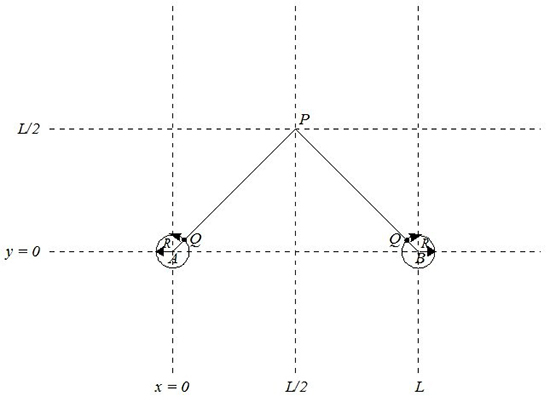Interference of Electromagnetic Waves
Problem 1
There are two points \( A (x = 0, y = 0) \) and \( B(x = L, y = 0) \) in the \( x \) - \( y \) plane in vacuum in which electromagnetic waves propagate with speed \( c \). About point \( A \) a charge \( Q \) moves with constant speed \( v \) in an anticlockwise direction in a circle of radius \( R \).
About point \( B \) a second identical charge moves with constant speed \( v \) in a clockwise direction in a circle of radius \( R \).
At \( t = 0 \) the first charge is at \( \left(x = \dfrac{R}{\sqrt{2}}, y = \dfrac{R}{\sqrt{2}}\right) \) and the second at \( \left(x = L - \dfrac{R}{\sqrt{2}}, y = \dfrac{R}{\sqrt{2}}\right) \) as shown below.

- What is the wavelength \( \lambda \) and frequency \( \nu \) of the radiation from each charge?
- Assuming \(R \ll \lambda \) and \( \lambda \ll L \), write an expression for the total radiated electric field \( \mathbf{E}(t) \) and \( \mathbf{B}(t) \) as a function of time \( t \) at the point \( P \left(x = \dfrac{L}{2}, y = \dfrac{L}{2}\right) \).
- Derive an expression for the flow of momentum per unit area and unit time at point \( P \).
› View/Hide Answers
Problem 2
At positions \( \left (-\dfrac{\pi}{b}, y(t), 0\right ) \) and \( \left (+\dfrac{\pi}{b}, y(t), 0\right ) \) there are two balls of mass \( m \) attached to ideal springs of constant \( k \). The balls, each of which has a charge \( Q \) on it, are constrained to move in the \( \pm y \) direction.
There is an electromagnetic wave propagating in the \( +x \) direction with electric field \( \mathbf{E} = A \mathbf{\hat{y}} \cos (at - bx) \) (with \( a > 0, b > 0\)) which excites the two oscillators.

Write down an expression for the steady state total magnetic field due to only the radiation by the two charges, at the locations
- \( x = -r, ~ y = 0, ~ z = 0 \) at time \( t \) and
- \( x = 0, ~ y = 0, ~ z = r \) at time \( t \)
for \( r \gg \pi/b \) and \( r \gg \) length of the springs.
Assume the system is in vacuum, there is negligible (but not zero) friction and that, from the point of view of motion of the balls, you can ignore energy loss due to radiation and the interaction between the two balls. Furthermore assume there are no electromagnetic interactions with the springs.
› View/Hide Hint
› View/Hide Answers
« Previous
